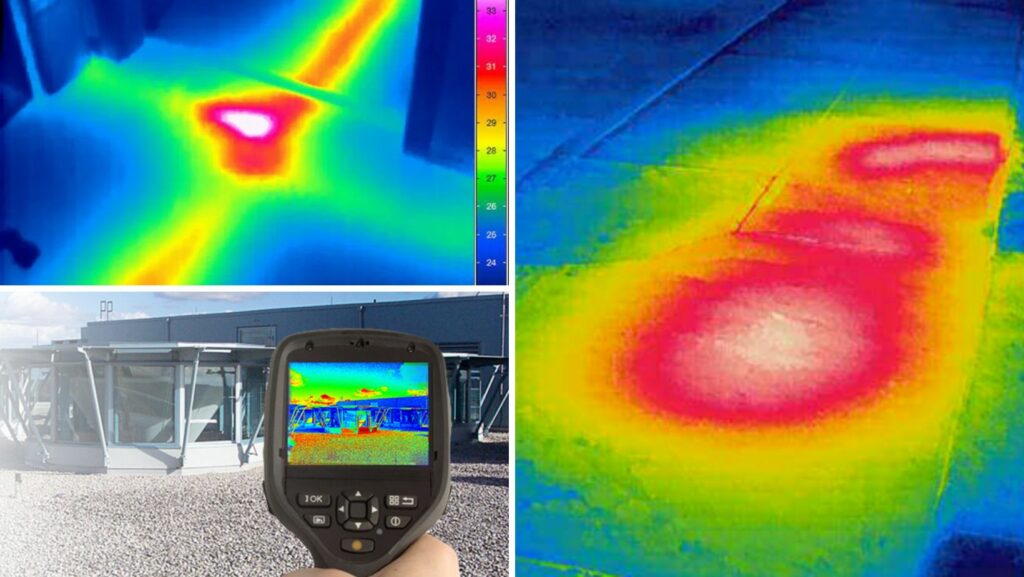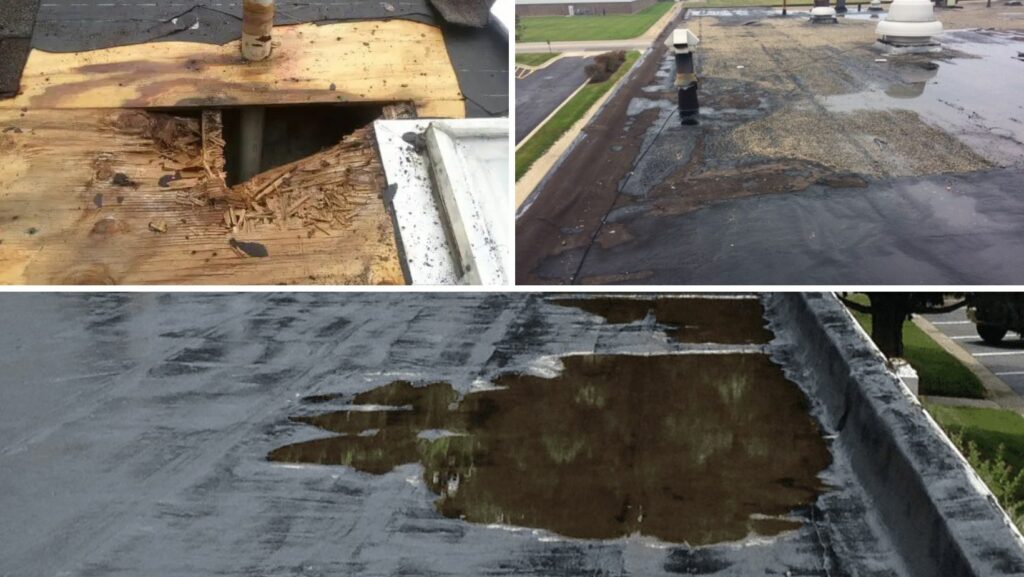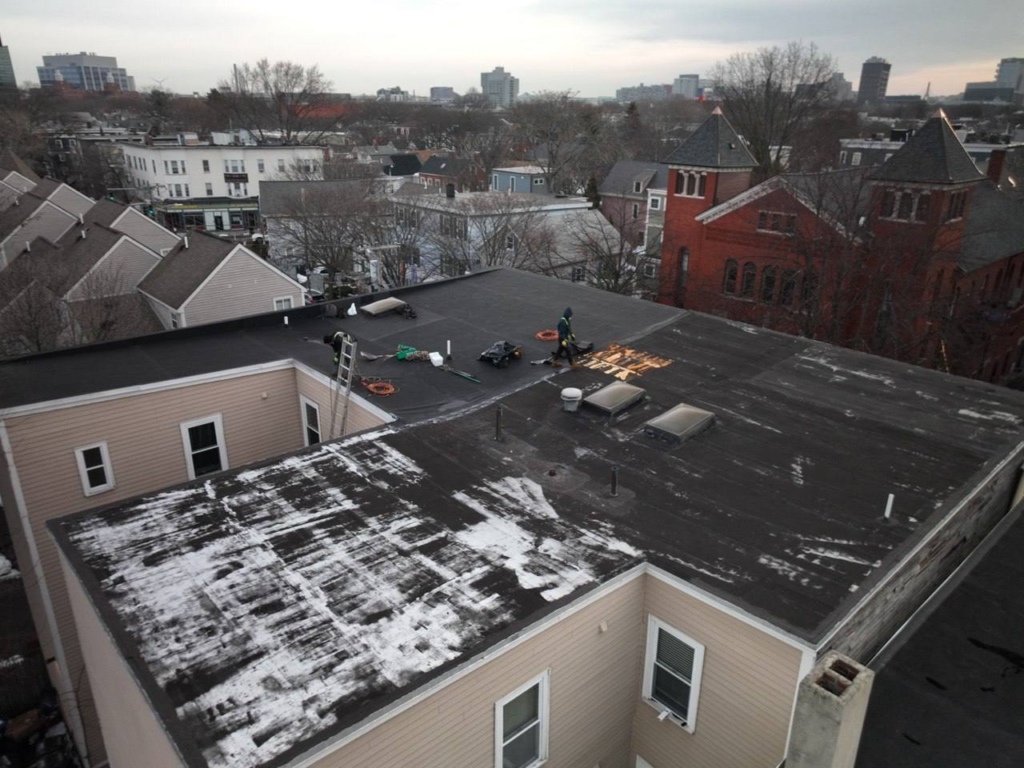Roof Leak Detection: Find Issues Before They Get Worse
Reading Time: 7 minutesGot a roof leak? Detecting one early is key. This will show you how to spot the signs of a leak and what to do. Read on to learn the top roof leak detection methods and prevent damage.
Quick Facts
- Do regular visual checks to catch roof leaks early—look for water spots, damaged shingles, and mold!
- Use thermal imaging and electronic leak detection to find hidden roof problems.
- Be proactive with regular maintenance, including gutter cleaning and attic checks to stop roof leaks before they start!
Visual Inspection Methods

Before:
Visual inspections are your first line of defense against roof leaks. Imagine yourself standing in your yard, looking up at your roof. What should you be looking for? Start with the obvious: water spots on walls or ceilings usually mean a leak. Damaged shingles – cracked, curled or missing – are big red flags. Even granule loss in asphalt shingles is a sign of trouble.
After:
When doing a visual inspection for roof leaks look for:
- Water stain on walls or ceilings which usually means a leak
- Damaged shingles – cracked, curled or missing
- Granule loss in asphalt shingles which is a sign of trouble
By looking for these signs and others you can catch problems early.
Next, focus on the other parts of the roof. Check for loose, broken or worn flashing around chimneys and vents. Misaligned or clogged gutters can cause water to back up and lead to leaks. Mold or mildew on exterior walls is another sign of moisture issues which could be related to roof leaks. Spot these visual clues to fix roof leaks properly.
Don’t forget to check the areas that are often overlooked. Rotted decking and mold on exterior walls can also be a sign of underlying roof problems. Dried stains or wet spots on walls and ceilings are clear signs of roof leaks. Regular visual checks can catch problems early and prevent major repairs.
Knowing what you’re looking for is key. Whether it’s damaged shingles, faulty flashing or clogged gutters, knowing what and where to look will make all the difference. So grab a pair of binoculars, get outside and do a visual inspection of your roof. Your proactive approach today will save you from a leaky disaster tomorrow.
Attic Access for Leak Detection

The attic is a goldmine of clues for roof leaks. Before you go up make sure you have the right safety gear and check the ceiling is solid. Once you’re in the attic start your search above where the leak is on the ceiling. Look for moisture signs – damp spots on roof trusses or insulation, dark or shiny patches. Check the attic floor for pooling water which can be a sign of a leak source. These are usually signs the water is coming through the roof.
Another way to look is for bright spots in your attic which means light is coming through gaps in the roof. These gaps can be entry points for water. Check around roof penetrations like chimneys and vents as these are common areas where leaks occur.
Regular attic checks can catch leaks early and prevent damage to your home.
Water Testing Methods
When visual inspections don’t show the source of the leak water testing can help. The process is simple and effective: Roofers apply water to the suspected area of the roof to simulate rain and see where the leaks occur inside the structure. This method will pinpoint the exact location of the leaks that are hard to find during dry spell.
Make sure the area is dry before you start a water test. To control the leak area limit the water flow and catch any leaking water with a bucket. If water enters, you can adjust by testing other areas of the roof to confirm the source of the leak.
This method is performed by experienced roofers and is effective in finding leaks and preventing further water damage.
Advanced Electronic Leak Detection
Electronic leak detection is the future of technology. Systems like IntegriScan can detect breaches in waterproofing membranes during construction and locate active leaks in existing buildings. What sets IntegriScan apart is its compliance with ASTM Practice D8231 and ASTM Guide D7877 standards which means it’s reliable and accurate. FM recognizes this system for its leak detection.
Another is PermaScan which provides monitoring with minimal disruption. FM approved system monitors moisture and extends the life of the waterproof membrane.
Electronic leak detection is reliable. You’ll get honest advice too. Such advanced methods are worth it for roof integrity and to save you costly damage.
Thermal Imaging Technology

Thermal imaging technology is another great tool for leak detection. A thermal camera will show temperature discrepancies that means moisture is present. This will give you visual evidence of leaks even if you can’t see the cause. Non invasive and useful for hard to reach areas or when other methods can’t find the problem.
Thermal imaging as part of your maintenance will catch issues early and keep your living space dry. The technology will show temperature differences which will reveal hidden moisture that would have gone unnoticed. Fixing these differences will prevent minor issues from becoming major repairs.
Common Causes of Roof Leaks

Before:
Knowing the common causes of roof leaks is key to detection and prevention. One of the main culprits is damaged or missing shingles which can expose the roof decking to the elements. Improper installation of roofing materials and extreme weather conditions like hurricanes, hail and lightning strikes can also cause leaks.
After:
Knowing the common causes of roof leaks is key to detection and prevention. Here are some of them:
- Damaged or missing shingles which can expose the roof decking to the elements
- Improper installation of roofing materials
- Extreme weather conditions like hurricanes, hail and lightning strikes
Another is clogged gutters. When debris accumulates in gutters water will back up and leak into the house especially if the gutter is not properly installed. While clogged gutters alone won’t cause roof leaks but can make existing problems worse.
Moss growth is another one as it can push beneath shingles and deteriorate them over time and cause leaks. Flashing the material used to seal joints around chimneys and vents is also a common source of leaks when it’s damaged or improperly installed.
Poor ventilation can also cause moisture buildup, mold and water damage all of which can cause roof leaks. Knowing these causes will allow homeowners to act on it and protect their roof and prevent leaks.
Roof Leaks Repair

Once a roof leak is found, prompt repair is key to minimize damage. One of the common repair is replacing damaged shingles. For asphalt shingles this means removing and replacing the worn out pieces. Pipe boot failure often caused by aging neoprene boots is another common issue that requires replacing the damaged plumbing vent boots.
Flashing issues must be addressed as compromised or improperly installed flashing can cause significant water intrusion. Sealing roof joints with new flashing will prevent leaks in vulnerable areas. Chimney leaks often caused by flashing problems need similar attention. For skylights make sure components are installed according to manufacturer’s instructions to prevent leaks.
For more complex cases hiring a licensed roofing contractor is the way to go for safety and effectiveness. Experienced roofing professionals can identify and fix the root cause of the problem and prevent further damage. Regular maintenance and inspections will detect potential leaks early and allow for timely repairs and extend the life of your roof.
Preventative Measures for Roof Maintenance: Tips for Effective Roof Leak Detection
Prevention is always better than cure especially when it comes to roof maintenance. Regular maintenance and inspections will identify potential leak sources before they become big problems. Start by cleaning organic debris from the roof to prevent moisture retention which can damage shingles. Trim tree branches near the roof to avoid damage to shingles caused by rubbing during windy conditions.
Inspecting the attic will show you the underside of the roof and will help you identify issues like mold or warped wood. Check the tightness of seals around roof penetrations like vent pipes to prevent leaks from deteriorating gaskets. Monitor for ice dams as it can form when snow melts at the roof eaves and can cause leaks.
Being proactive in roof maintenance will increase the longevity and integrity of the roof structure. Regular inspections by roofing professionals will ensure that any issues will be detected and addressed early. Taking these preventative measures will save homeowners from costly repairs and extend their roof’s life.
Understanding the Basics of Flat Roof: Read Now
Massachusetts Commercial Roof Gutter Installation: Code Requirements and Best Practices
Finding Reliable Roof Leak Repair Services
High-Quality PVC Roof Installation at 23 St Marys Ct, Brookline, MA
Understanding Hail Damage: Causes and Solutions
Comprehensive Roofing Renovation at 7 Craigie Circle, Cambridge, MA
Efficient White PVC Roof Installation at 54 Solaris Rd, Hyde Park, MA
Conclusion
In summary, finding roof leaks early will prevent extensive damage and costly repairs. From visual inspections and attic access to electronic leak detection and thermal imaging there are many ways to detect leaks before it gets worse. Knowing the causes and taking preventative measures will further protect your roof. Remember a proactive approach to roof maintenance will save you time, money and stress in the long run. Keep your roof in shape and be at peace.
Watch out for water stains on ceilings and walls, damaged shingles or any mold and mildew—these are sure signs your roof is leaking! Catch these early and save time and money!
Yes! Start by checking the ceiling for any signs of moisture or light and make sure you have the proper safety gear before you go in. Be careful and you will be safe while looking for leaks!
A water test is a fun hands-on way to detect leaks by simulating rain on a suspected area and see where water seeps in! It’s a simple method to address hidden issues fast!
Yes! Electronic leak detection systems like IntegriScan and PermaScan will not only detect leaks accurately and non-invasively but will also extend the life of your waterproof membranes! It’s a total game changer for maintenance and efficiency!
Prevent roof leaks by doing regular maintenance, keep debris off your roof and inspect your attic and flashing!
Denis is the driving force behind ID Flat Roof, a leading company in Boston specializing in flat roof repair and installation for over 20 years.
Expertise:
Denis excels in PVC, TPO, EPDM, and rubber roofing. His meticulous approach ensures quality and customer satisfaction.
Innovation:
Denis incorporates cutting-edge solutions like skylights and solar PV roofing.









